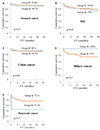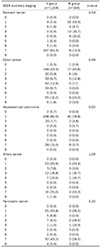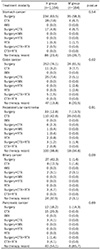Abstract
Background/Aims
Public hospitals were established to provide high quality medical services to low socioeconomic status patients. This study examined the effects of public hospitals on the treatment and prognosis of patients with five-major gastrointestinal (GI) cancers (stomach cancer, colon cancer, liver cancer, bile duct cancer, and pancreatic cancer).
Methods
Among the 1,268 patients treated at Seoul National University Boramae Medical Center from January 2010 to December 2017, 164 (13%) were in the medicare group. The data were analyzed to identify and compare the clinical manifestations, treatment modality, and clinical outcomes between the groups.
Results
No statistically significant differences in the clinical data (age, sex), treatment method, and five-year survival rate were observed between the health insurance group and medicare group in the five major GI cancer patients. On the other hand, some medicare group patients tended more comorbidities and fewer treatment options than health insurance patients.
Figures and Tables
 | Fig. 1Five-year survival rate of patients between the health insurance group (group H) and medicare group (group M). (A) Stomach cancer. (B) HCC. (C) Colon cancer. (D) Biliary cancer. (E) Pancreatic cancer. F/U, follow up; HCC, hepatocellular carcinoma. |
Notes
References
1. Ferlay J, Soerjomataram I, Dikshit R, et al. Cancer incidence and mortality worldwide: sources, methods and major patterns in GLOBOCAN 2012. Int J Cancer. 2015; 136:E359–E386.

2. GBD 2013 Mortality and Causes of Death Collaborators. Global, regional, and national age-sex specific all-cause and cause-specific mortality for 240 causes of death, 1990–2013: a systematic analysis for the global burden of disease study 2013. Lancet. 2015; 385:117–171.

3. Jung KW, Won YJ, Kong HJ, Lee ES. Community of Population-Based Regional Cancer Registries. Cancer statistics in Korea: incidence, mortality, survival, and prevalence in 2015. Cancer Res Treat. 2018; 50:303–316.



4. Ngoma T. World Health Organization cancer priorities in developing countries. Ann Oncol. 2006; 17 Suppl 8:viii9–viii14.

5. Romero Y, Trapani D, Johnson S, et al. National cancer control plans: a global analysis. Lancet Oncol. 2018; 19:e546–e555.

6. Yabroff KR, Lund J, Kepka D, Mariotto A. Economic burden of cancer in the United States: estimates, projections, and future research. Cancer Epidemiol Biomarkers Prev. 2011; 20:2006–2014.



7. Brown ML, Lipscomb J, Snyder C. The burden of illness of cancer: economic cost and quality of life. Annu Rev Public Health. 2001; 22:91–113.


8. Bradley CJ, Yabroff KR, Dahman B, Feuer EJ, Mariotto A, Brown ML. Productivity costs of cancer mortality in the United States: 2000–2020. J Natl Cancer Inst. 2008; 100:1763–1770.



9. Cooper BS, Rice DP. The economic cost of illness revisited. Soc Secur Bull. 1976; 39:21–36.
10. Han KT, Park EC, Kim SJ, et al. Factors affecting the quality of life of Korean cancer survivors who return to the workplace. Asian Pac J Cancer Prev. 2014; 15:8783–8788.


11. Khang YH, Kim HR. Socioeconomic inequality in mortality using 12-year follow-up data from nationally representative surveys in South Korea. Int J Equity Health. 2016; 15:51.



12. Kim K, Kim JS. Factors influencing health-related quality of life among Korean cancer survivors. Psychooncology. 2017; 26:81–87.


13. Myong JP, Kim HR. Impacts of household income and economic recession on participation in colorectal cancer screening in Korea. Asian Pac J Cancer Prev. 2012; 13:1857–1862.


14. Lee KS, Chang HS, Lee SM, Park EC. Economic burden of cancer in Korea during 2000-2010. Cancer Res Treat. 2015; 47:387–398.


15. Lee SK, Sobal J. Socio-economic, dietary, activity, nutrition and body weight transitions in South Korea. Public Health Nutr. 2003; 6:665–674.


16. Young JL Jr, Roffers SD, Gloeckler Ries LA, Fritz AG, Hurlbut AA. SEER summary staging manual - 2000. Codes and coding instructions. Bethesda (MD): National Cancer Institute;2001.




 PDF
PDF ePub
ePub Citation
Citation Print
Print






 XML Download
XML Download